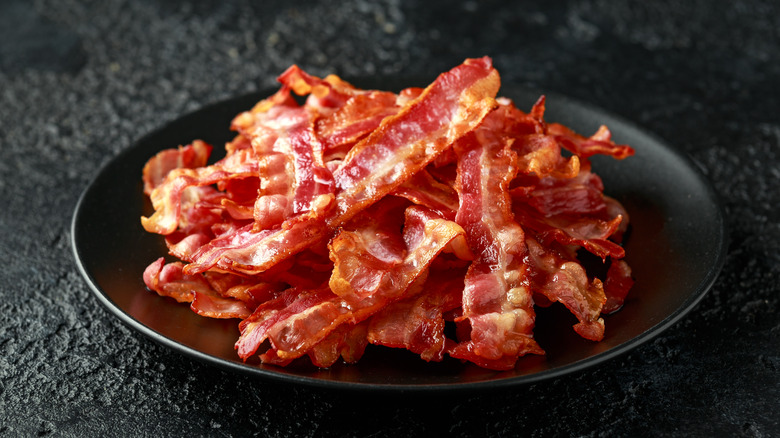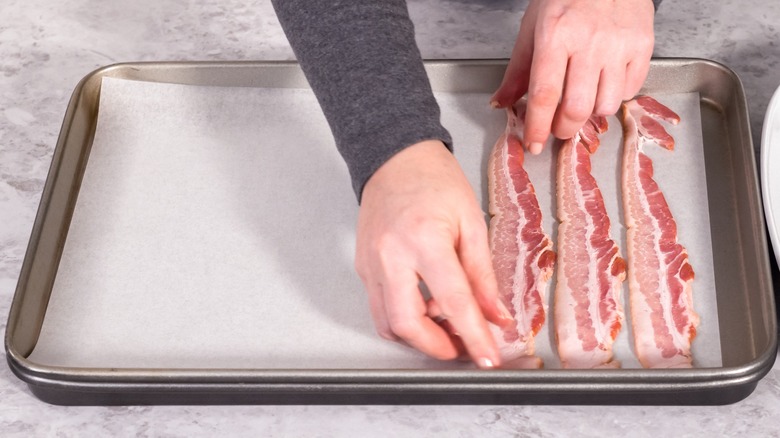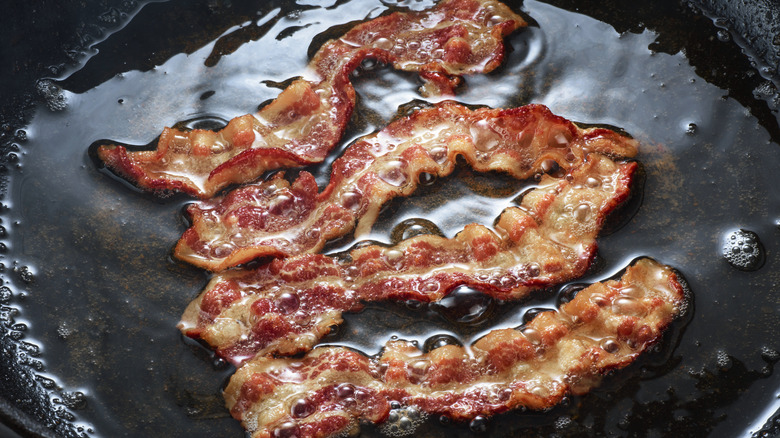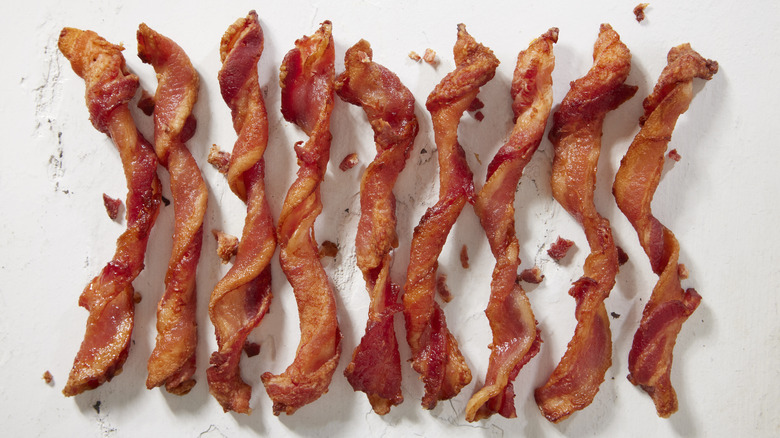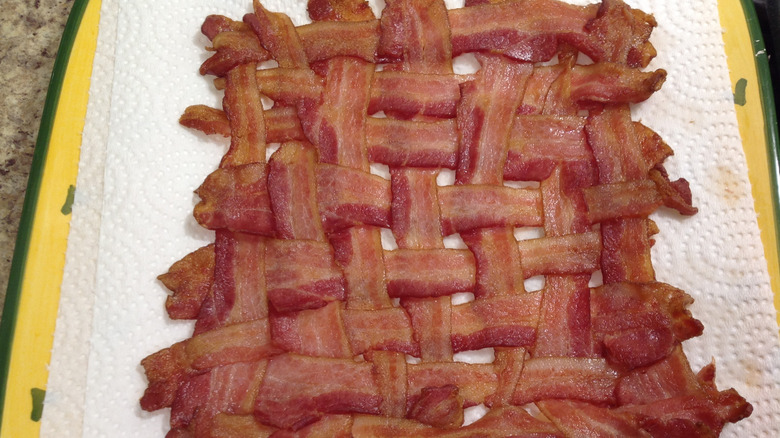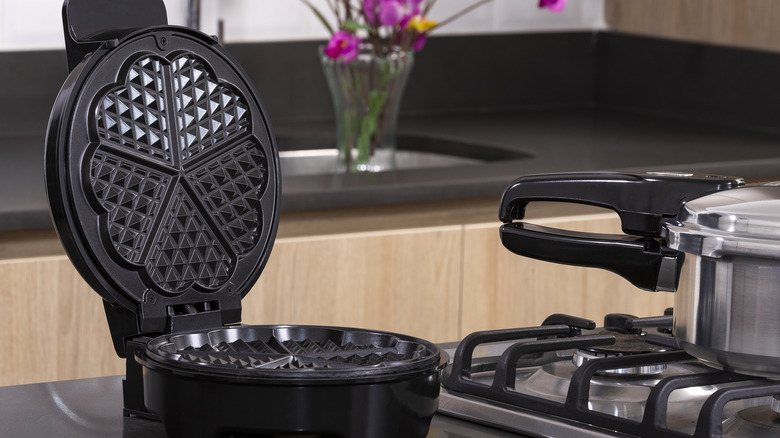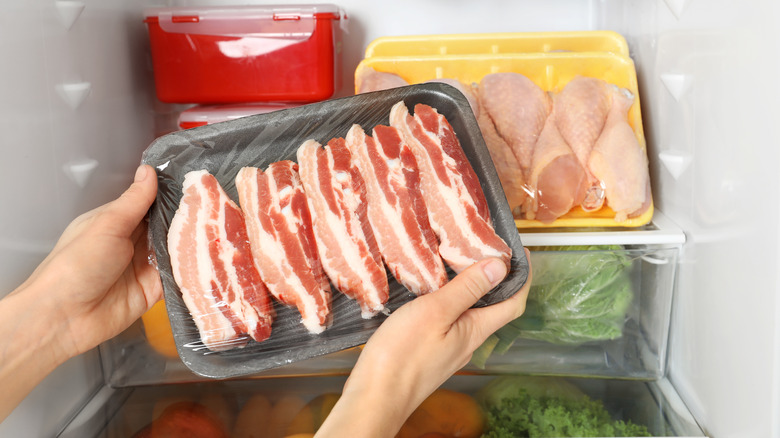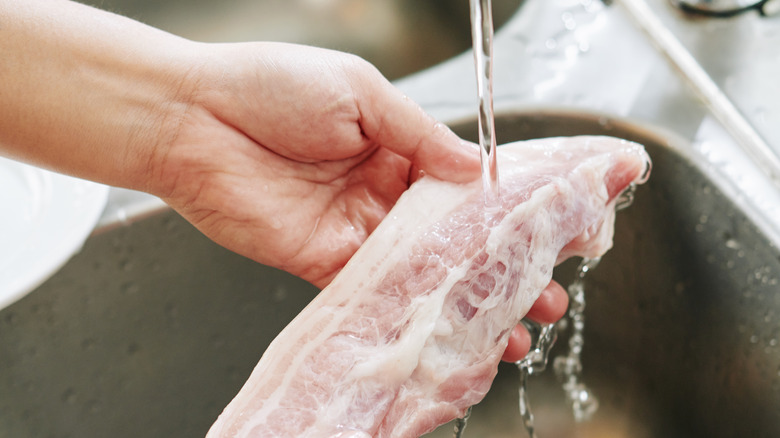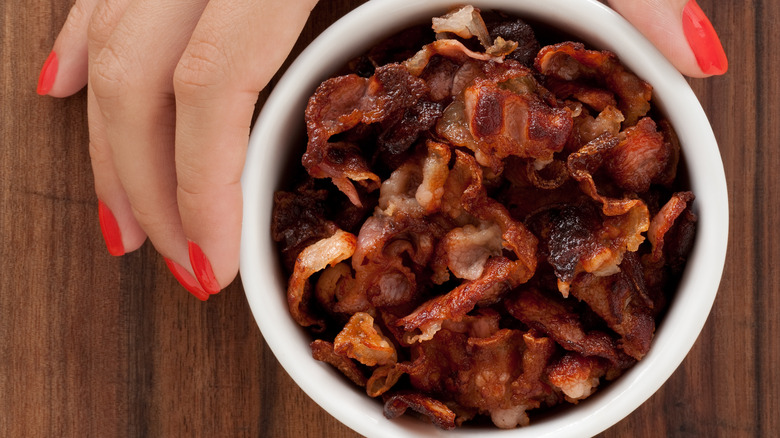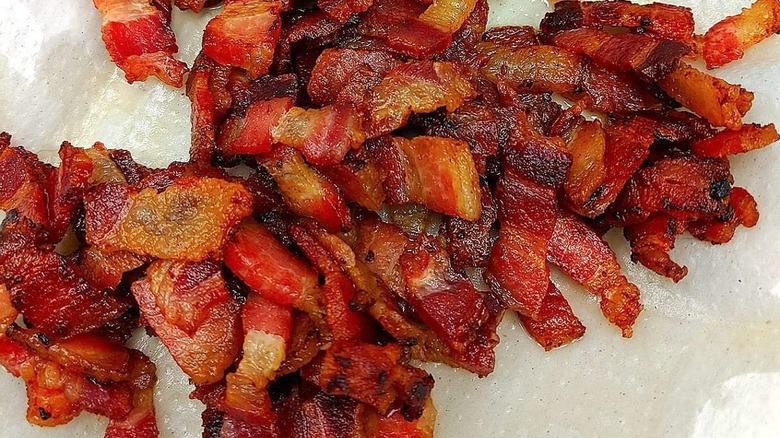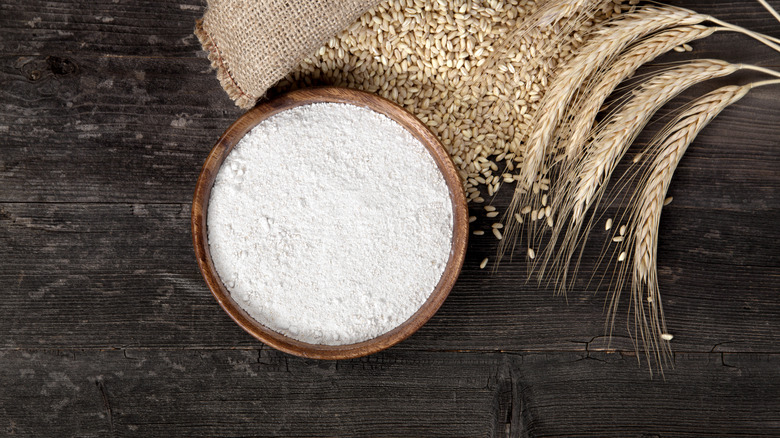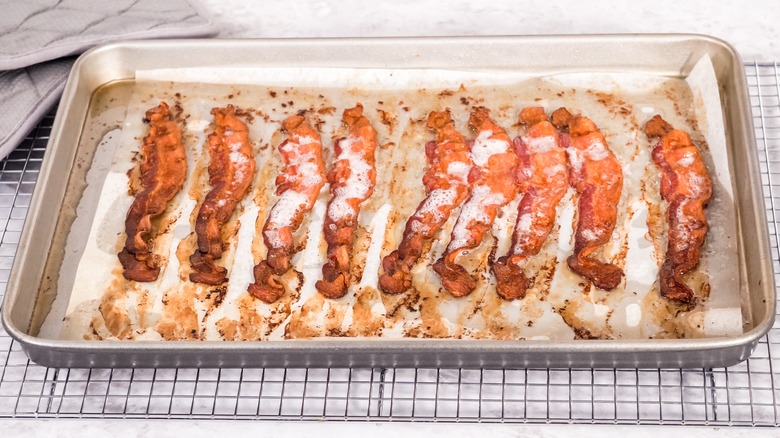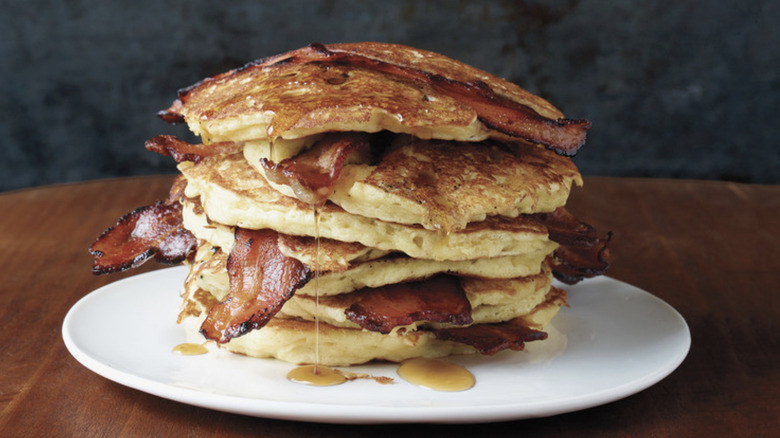14 Bacon Hacks That You Need To Know
In the United States, approximately 268 million people ate bacon at some point in 2020. The popularity of bacon is only set to increase as time goes on, with 275 million people projected to be enjoying it in 2024, according to Statista. And we can understand why.
Bacon has a rich, complex flavor that is obtained from the multitude of taste elements it packs into each slice. Smoky, sweet, savory, and salty flavor notes all combine in the meat, with certain tastes made even more intense when its fat breaks down during cooking.
The texture of bacon can make it even more delicious, with the slices being able to develop a crispy consistency like few other types of meat can. With all these positives, bacon just keeps getting better. Certain hacks and tricks in the kitchen can make preparing and storing your bacon a breeze, so you can worry less about the cooking and fully enjoy your meal.
1. To store your bacon, use parchment paper
Making good bacon starts with bringing a quality product home from the store –- but once you get it safely into your kitchen, what next? That's when the dance to actually get it out of the package begins. Bacon typically comes in vacuum-sealed packs, which are designed to limit oxygen access to the meat, extending its lifespan and sealing in moisture. But there's no denying that those packs are fiddly to open, and once you've done so, the meat can dry out fast.
Luckily, thanks to this parchment paper hack for storing bacon, you'll never have to worry about substandard slices again. All you have to do is pull out a long piece of parchment paper, lay it out on your counter, and place your slices on it one by one. Then, roll up the entire thing lengthways so that your bacon pieces are rolling into small cylinders surrounded by parchment paper.
Once you've done this, you then have to cut between the rolled-up slices with scissors, making individual bacon packages. You can then pile them into a Ziploc bag and pop them in the freezer or keep them in the fridge if you're going to use them in the next few days. Wrapping the bacon in parchment paper before bagging it up keeps the slices from sticking together when you freeze them. Additionally, it provides an extra layer of protection from freezer burn, which can cause the meat to deteriorate.
2. A little water goes a long way
On paper, water and bacon don't really go together. After all, the best bacon is crispy, with brittle edges that produce the perfect crunch when you bite into them — and water usually means soggy. But what might surprise you is that boiling your bacon produces an incredible crispiness that will make it become your go-to cooking method.
Now, naturally, we don't mean that you should put your bacon in a vat of boiling water and simmer it until done. Rather, you should place your bacon in a shallow skillet and then add just enough water to cover it, bringing it to a boil. This means that the meat and fat start to cook at a uniform pace, with the fat rendering out, all of which will eventually produce a great crisp once the water evaporates.
The water also keeps the meat plump and juicy, stopping it from drying out as the fat cooks. Once the water's completely gone, continue cooking the bacon in the hot pan until it's your desired level of doneness. Trust us, it really works.
3. Twist your bacon for the ultimate crisp
Think of bacon, and you likely think of flat slabs of meat, usually tucked onto the side of a plate with eggs and toast. But putting a simple twist on that shape is a great way to make it super-crispy. The bacon twisting hack is pretty simple: You take your slices of bacon and wind them around a wooden skewer to keep their shape. Then, you place them on a wire rack and cook them in your oven for half an hour. "The more twists you give, the crispier it gets," explains one user of this hack on TikTok.
This hack is particularly useful for folks looking for a keto-friendly snack, as the bacon pieces, when twisted, can be picked up and munched on like you would a breadstick. The secret to this method's crispiness comes from its unique shape.
When you twist bacon, you lock in a lot of the fat that bacon needs to achieve maximum crispiness while allowing the excess fat to render off. You also give the bacon an added density by twisting it, making it way more satisfying. In addition, twisting it gives it all sorts of nooks and crannies that add to its crunch.
4. Weave your meat for bacon in every bite
If you've spent any time on the internet in the last, say, 15 years, you've likely seen a bacon weave in your time. The practice of weaving bacon hit the mainstream in 2008 when a blog post explaining the technique, and how it can be used to create a casing for sausage meat, went viral, generating thousands of comments. But while it might seem wild, there's logic to making bacon in this form. Weaving bacon slices together until they form a lattice shape and baking it all in the oven gives you a solid block of meat that's perfect for sandwiches, sliders, or even as a layer in a casserole.
The added advantage of preparing it this way is that the bacon stays together, so when you come to bite into it, it won't fall apart. And once you've made a bacon weave, you can do all kinds of things with it. Try making smaller weaves and then baking them in a muffin tin, to make bacon cups. Or, for a truly wild sweet-savory dessert, make a bacon weave apple pie, with your meat forming part of the pie casing.
5. For a pan-free breakfast, cook your bacon in a waffle maker
While cooking bacon in a pan is a tried-and-tested method, it can get a little boring. So to keep your breakfasts exciting, pull out your waffle maker. Lay your slices of bacon out on the hot iron, close the lid, and allow it to cook for a few minutes. Pull it out, plate it up, and you're done. How easy is that?
Cooking bacon in a waffle iron has some positives that go beyond just being a novel way of making breakfast. For starters, the unique shape of a waffle iron will morph your bacon pieces into slices with all kinds of edges, bumps, and twists — all of which make the meat even crispier.
Additionally, the constant heat on both sides means the meat cooks evenly without flipping the slices, freeing you up to prepare the rest of the breakfast. And, while clean-up might seem tricky, many waffle irons have removable plates that you can pop in the dishwasher after you're done.
6. To get the best results, let your bacon rest
Resting is an important part of the cooking process for many types of meat. Allowing your steak or chicken to rest after cooking lets the juices settle back into the meat, making every mouthful more moist and tender. With bacon, however, we tend not to think about resting it post-cooking. And while it may be beneficial to do so, especially with thicker cuts of bacon which have more natural moisture than the thinner slices, it's arguably far more useful to rest it before you cook it, especially if it's been in your fridge.
In your refrigerator, your meat naturally gets colder, and this can present some problems when you cook it. Not only will it shrink upon hitting the pan, but it also won't achieve peak juiciness. Furthermore, the meat-to-fat ratio in bacon presents problems when cooking it cold, as fat stays cold for longer than meat does, meaning you'll end up with bacon that's cooked at different levels. You have to take your meat out of the fridge about 15 minutes before cooking it and allow it to come up to room temperature.
7. For bacon in stews, do what Alex Guarnaschelli does
A few stews just don't feel complete until bacon's joined the party. Bacon, with its ability to bring a huge amount of flavor for its buck, has an uncanny ability to take a seemingly-ordinary stew and amp it up to the next level. But unfortunately, stews present a problem for crispy bacon in that they're, well, full of water. And water and crispiness don't exactly go together.
But this Alex Guarnaschelli cooking tip will banish soggy bacon in your stews forever. The celebrity chef offered up her quick and easy hack on Twitter. Instead of cooking your bacon as the recipe might dictate, fry it off separately in a pan a few minutes before the stew is complete until it's as crispy as you like. Then, scatter it into the stew just before you're about to serve it. Make sure you stir it a little so the flavor can spread through the whole stew. By doing this, you'll keep your bacon's texture, while still getting all the benefits.
8. If your bacon's shrinking, give it a quick rinse
One of the most annoying things about bacon is how quickly it can shrink, with slices often reducing considerably in size when they hit the hot pan. But there's one quick hack that can stop this from happening so drastically, and it's one that you might not expect. All you have to do is give your bacon a quick rinse under the tap before cooking it in the oven, which can reduce shrinkage considerably. By doing this, you remove some of the fat from the bacon, which can be a factor in making it smaller when it's cooked.
Remember, though, that while rinsing your bacon can stop it from shrinking somewhat, if you have low-quality bacon, it won't prevent it entirely. The only way to truly stop your bacon from shrinking is by buying a good-quality product. While bacon can shrink because of its fat content, it can also do so due to having a high water volume, added by manufacturers to plump it up. Well-made bacon, on the other hand, is all meat.
9. To freeze your bacon, roll it up
Bacon freezes exceptionally well, and it's great to know that if you're not ready to eat the whole pack yet, stashing it in the freezer can ensure you can enjoy it at a later time. But the process of freezing it is another issue. Too often, people place a big slab of bacon slices directly in their freezer, only to find that they want one or two pieces but have to defrost the whole thing or else have to try and chip off a piece.
This genius hack, however, will stop you from that pain and give you just the bacon that you need. Separate your block of bacon into slices, and then roll each one up lengthways. Once you have your individual bacon rolls, place them all into a Ziploc bag, nestled next to each other like little meaty parcels.
Squeeze out all of the air from the bag, and place it flat in your freezer. Next time you need a slice, the bacon should be easy to separate. If you want to make it even easier to keep them individual, try placing them on a baking sheet first when rolled up and freezing them with space between them for approximately 20 minutes before transferring them to the bag.
10. For crispy bacon, use a bowl
There are a million and one recipes that promise crispy bacon, but it's likely that not all of them work. And it's even less likely that you'll believe that you can produce it in the microwave. But crispy bacon in the microwave is entirely achievable, and all it takes to get there is a bowl. All you have to do is layer your bacon slices in a bowl, placing a plate underneath to catch the fat and nuke it for roughly one minute per slice of bacon.
Cooking bacon in the microwave is essentially the same process as cooking it in a pan, with the meat and fat heated by the electrons instead of going directly into your food. And as the fat heats up and starts to cook, it begins to render off the bacon's solid structure, which is an essential stage in it becoming crispy.
The use of a bowl allows the bacon fat to pool at the bottom instead of going all over your microwave, and the plate underneath works to capture any extra spillages. If your bacon isn't quite as crispy as you'd like it when your timer pings, microwave it for a little longer.
11. Fold your bacon to enjoy bite-size treats
If there's one thing we don't love about bacon, it's how thin it can sometimes be. Those flimsy slices that you find in the grocery store can not only be pretty unsatisfying but can also be lacking in flavor due to simply not having enough meat to deliver all the complex taste notes in the food. But if you can't find thick bacon, there's a nifty hack that not only beefs up your slices but makes the meat into chunky yet bitesize morsels.
Pull out all of your bacon slices, and lay them on a sheet pan lined with parchment paper. Then, fold the bacon in on itself using two folds, first from one end, then the other, to make a smaller rectangular shape. Pop the pan into the oven at 400 degrees Fahrenheit for about 20 minutes, giving it an initial blast of cooking.
After this, pull out the pan, and flip over the bacon pieces before cooking them for another 20 minutes at the same heat. The result is a snack that's been dubbed "purse bacon" over on TikTok — super-crispy, dense bacon pieces that you can pop in a plastic bag and enjoy from your purse on the go.
12. A quick dredge of flour can make your bacon extra-crispy
Think bacon, and you likely think of crispy, brittle rashers that seem ready to snap with the lightest of pressure. Bacon has the ability to crisp up excellently, thanks to its high-fat content, which renders off during the cooking process, allowing the firm structure that's left over to firm up. But it can be difficult to get this right, and too often, bacon can end up droopy and soft.
Luckily, though, there's a hack for all those crispy bacon lovers out there, and it involves a surprising ingredient: flour. You take your slices of bacon and dredge them in all-purpose flour before frying them as you normally would. Doing this helps to eliminate the biggest enemy of crispy bacon, which is moisture. The flour that your bacon is dipped in will soak up any of the excess water or fat in your meat, reducing leakage and keeping your slices dry and crispy.
Flour also provides a heat barrier between your bacon and the hot pan. This will prevent your bacon from scorching, which can often happen when you're cranking up the heat in pursuit of crispiness. Instead, you'll end up with nicely-browned, crunchy slices.
13. Ina Garten's sheet-pan trick will level up your bacon
Leave it to Ina Garten to show us how to really nail a classic food. Instead of using a pan, Garten turns up the heat of her oven, cooking her bacon by roasting it on a large sheet pan at 400 degrees Fahrenheit. By cooking bacon in the oven, Garten blasts the meat with uniform, continual heat, ensuring that everything cooks at the same pace and the fat renders off nicely.
She also removes the potential guesswork of using a pan that might have cold spots, which could provide an uneven result for your bacon. And, to top it all off, cooking bacon in the oven requires pretty minimal effort: You just pop it in, wait, and enjoy.
While a nonstick sheet is best for cooking bacon in the oven, you can also line a regular baking sheet with parchment paper. Parchment paper's nonstick qualities will make removing the bacon a breeze and will reduce the amount of time it takes to clean up afterward. Once you've removed your bacon from the pan, though, remember to place it on a wire rack to drain off any excess fat.
14. Combine bacon and pancakes for a dynamite breakfast
Pancakes have been around for thousands of years, dating back as far as Ancient Greece. But as a breakfast food, their popularity exploded when the Aunt Jemima brand was developed in 1889, delivering the first pancake ready mix to the masses. With their mild taste and slight sweetness, pancakes provide the perfect counterpoint to the salty, fatty flavor notes of bacon. Preparing them separately, though, can be somewhat time-consuming.
Well, not anymore. Introducing "Pancacon," a dish that cooks the pancakes around the bacon itself. By preparing the ingredients in this way, you do away with the need to wash up several pans and spatulas and form a one-piece breakfast that's easier to eat. Cook your bacon as you normally would in your skillet, and then drain it off on a little paper towel. Wipe your skillet with a piece of paper towel, to remove the fat from the pan, and then place the bacon back onto the skillet.
Then, take some pancake batter, and ladle it over the bacon slices, so that it forms a pancake shape around it. It can be useful to use a squeeze bottle here, so you can pour it into your desired shape. Let it cook for a few minutes before flipping them over, cooking on the other side, before serving them up.
